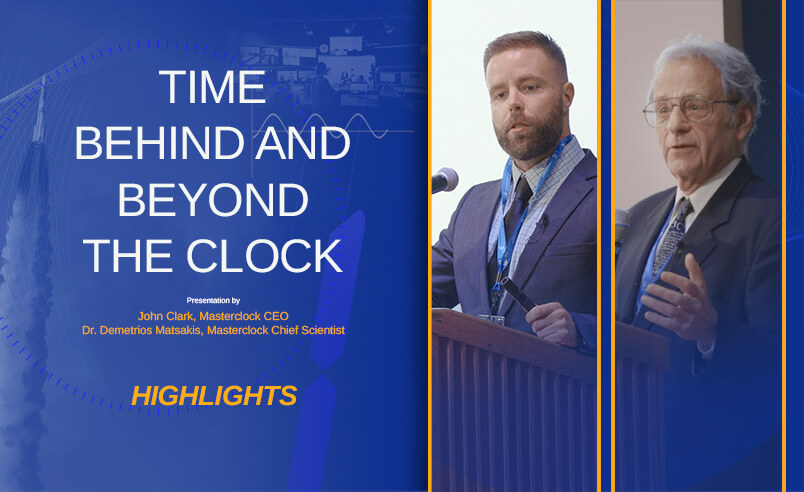The latest news on pulsar J1906+746 gives me an opportunity to spout off. For almost all my life, I’ve heard that pulsars can be great clocks. But that was only after they ruled out “ET communications” and realized pulsars are small (10 km), rapidly spinning (> once per second), highly magnetized, burned-out stars composed mostly of neutrons—neutron stars. Remember that in 1967, when Jocelyn Bell and Anthony Hewish discovered pulsars, cesium beam clocks were just laboratory toys and the best time keepers were our solar system’s planets.
01/13/20 By Dr. Matsakis
My Spin on Pulsars
Unfortunately, the original pulsars were found to be far less stable than atomic clocks. But claims were renewed 15 years later when Don Backer and Shri Kulkarni discovered B1937+21 (The Millisecond Pulsar). Millisecond pulsars rotate hundreds of times per second and are much more stable. In 1997, my name was on a paper that had this plot. [1]
The upper three curves showed that after a few years of averaging, millisecond pulsars were comparable to the best terrestrial timescales before 1995, though the lower two curves showed that just a single HP5071 cesium—which went into large scale production a few years earlier—was more stable than any pulsar for up to three years averaging.
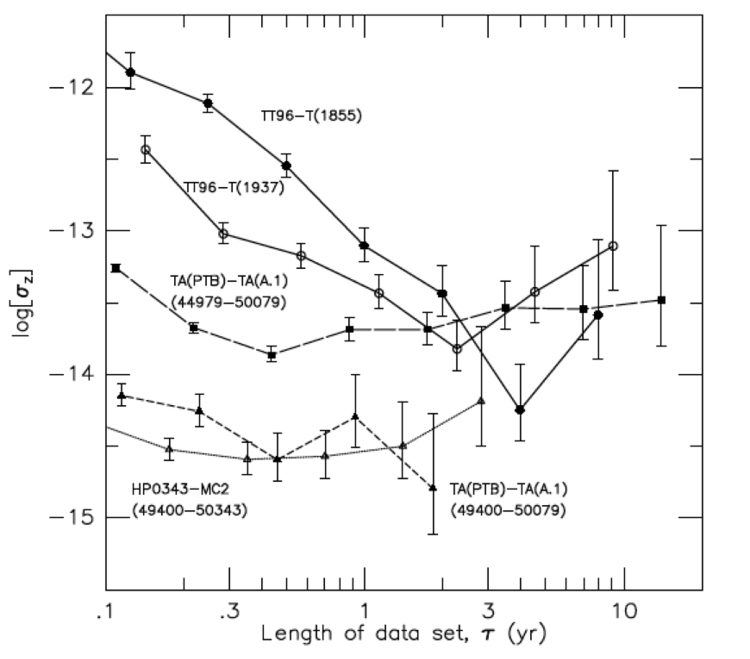
Since then we have put atomic fountains in operation, which routinely measure frequencies over 100 times better than we could in the 90s, and optical clocks, our latest “laboratory toys,” are at the point of becoming operational with another 100 times greater precision. Yet predictions of great things from pulsars at super-long timescales are still being made—in at least one conference paper per year. Worse, pulsars cannot ever give an absolute frequency, because they spin at wildly different rates. They cannot even realistically give an absolute frequency drift, because they slow down at different rates, depending on their magnetic field and other properties.
But enough pulsar trashing. They could provide a useful third-order stability test on a 30-year scale, under the unlikely assumption that terrestrial clock technology does not continue its rapidly-accelerating advancement. Pulsars for time would be analogous to measuring with a ruler that has no markings. You could tell if a timescale has no kinks, but not if it has the wrong frequency or even the wrong frequency slope. In fact, pulsars can “see” the kink caused by an artificial change added to UTC in the late 90s to take into account a previously unrecognized systematic correction needed in atomic clocks. That is the bump on the left-hand side of this figure, which comes from a to-be published paper on which I am a minor coauthor [2]:
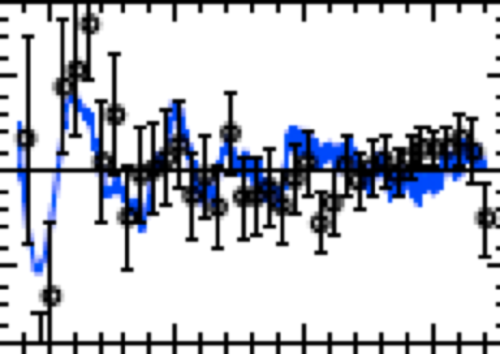 So if there is something wrong with our atomic clocks on decadal time scales, pulsars might show it. But more importantly, even if pulsars do not provide the best means to know what time it is, they will help us in knowing what time is.
So if there is something wrong with our atomic clocks on decadal time scales, pulsars might show it. But more importantly, even if pulsars do not provide the best means to know what time it is, they will help us in knowing what time is.
Newton thought it obvious that time flows evenly throughout the universe, but modern physics is based on Einstein’s special and general relativity theories (GR), which absolutely require that there is no absolute time. While a clock attached to any observer will record their “proper time,” the relative rates of these clocks will depend on the observers’ relative speeds and gravitational field density. GR has been proven in many ways—GPS would not work if we did not account for GR in the receiver math. And it is being frequently tested in many ways—even I gave GR a test a few years ago, looking for solar cycles in GPS data. (It’s a good thing I confirmed GR, because nobody would have believed me.) But all these tests are where gravity is comparatively weak, and on laboratory to planetary scales. Even on galactic scales, GR has so far successfully defended itself against MOND theories, which would explain galactic rotation curves not as a violation of GR but rather as the effects of dark matter.
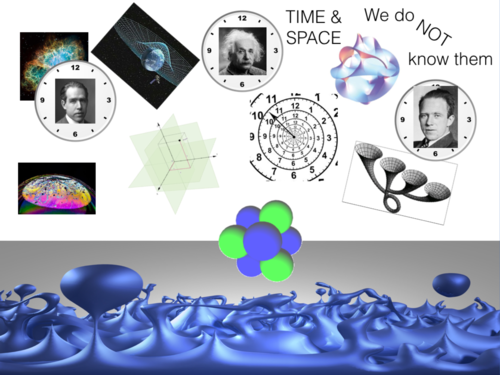 But while there are no creditable anti-Einstein theories, there are many post-Einstein theories. Going to the tiny Plank scale, books have been written and conferences held on how the union of relativity and quantum mechanics leads to such concepts as the Quantum Foam, in which time and space are totally chaotic at the level of 10-43 seconds and 10-35 meters. This inspired the following clip-art from me. I tried to insert it into a paper I published in the 2015 Science of Time Conference, but it did not survive the U.S. Naval Observatory’s internal review:
But while there are no creditable anti-Einstein theories, there are many post-Einstein theories. Going to the tiny Plank scale, books have been written and conferences held on how the union of relativity and quantum mechanics leads to such concepts as the Quantum Foam, in which time and space are totally chaotic at the level of 10-43 seconds and 10-35 meters. This inspired the following clip-art from me. I tried to insert it into a paper I published in the 2015 Science of Time Conference, but it did not survive the U.S. Naval Observatory’s internal review:
A second chance opportunity to publish my artistic interpretation of Quantum Foam.
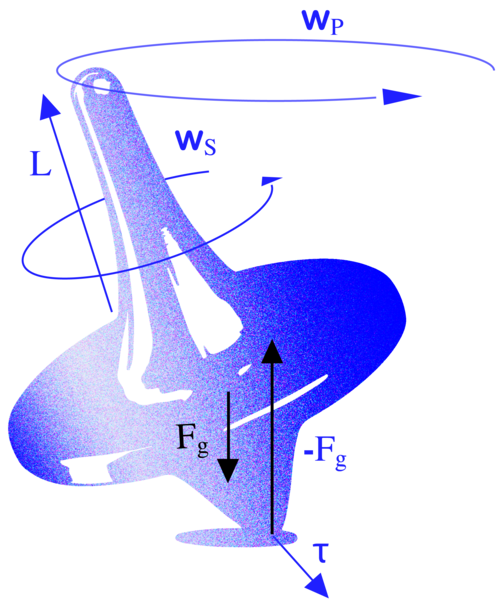 The great contribution of pulsars is to test relativity in a new regime—that of strong gravity. Joe Taylor received the Nobel Prize for showing the 8-hour orbit of the binary pulsar B1913+16 met all the predictions of relativity, including gravitational radiation. And now we come to J1906+0746—it’s unusual even for a pulsar, and not just because its orbital period is only 4 hours. It spins at an angle essentially in the plane of its orbit. This results in rapid precession, strong gravitational radiation, and three more successful tests of GR in strong gravity at the level of a few percent. The technical article can be found here: https://arxiv.org/pdf/1909.06212.pdf.
The great contribution of pulsars is to test relativity in a new regime—that of strong gravity. Joe Taylor received the Nobel Prize for showing the 8-hour orbit of the binary pulsar B1913+16 met all the predictions of relativity, including gravitational radiation. And now we come to J1906+0746—it’s unusual even for a pulsar, and not just because its orbital period is only 4 hours. It spins at an angle essentially in the plane of its orbit. This results in rapid precession, strong gravitational radiation, and three more successful tests of GR in strong gravity at the level of a few percent. The technical article can be found here: https://arxiv.org/pdf/1909.06212.pdf.
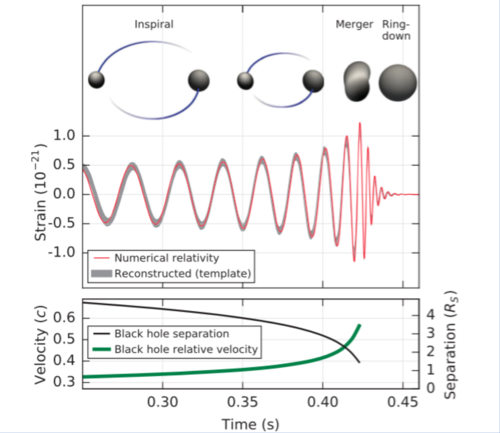 A rendering of precession.
A rendering of precession.
We’ve all read about the exciting discovery of gravitational radiation by LIGO. This confirms a prediction of Einstein’s theories with gravitational waves from black hole merges, with events that last less than one second. Among other things, LIGO has shown that all the gold (and heavier elements) in the universe are created as ejecta from neutron star-neutron star mergers. This figure is from forbes.com:
Pulsars can complement LIGO because they are being used to search for gravitational radiation waves that last for decades.
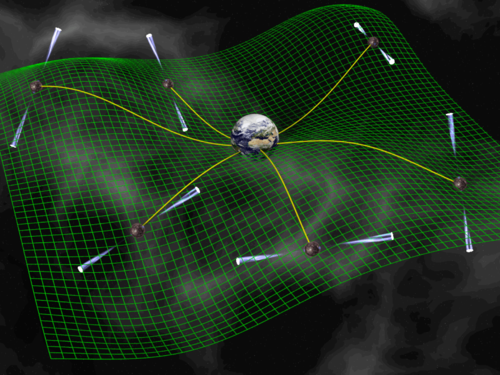 Courtesy of astrobites.org
Courtesy of astrobites.org
The incorporation of GR into a Theory of Everything was a quest that eluded Einstein, and Hawkins too. But that fact has deterred no one. Theorists can and should speculate, but it is recognized that the breakthrough will most likely happen when one or both of those theories are tested under new conditions, and fail to explain the data. Pulsars can test GR in the strong gravity and long-wavelength regime, LIGO and cooperating gravitational radiation detectors can test GR on cosmological scales, while Quantum Mechanics can be pushed to both planetary and ever-smaller length scales. Like basketball players grabbing rebounds, eventually we will slam our knowledge into a hoop of deeper understanding. I hope that happens soon.
Footnotes
[1] D. N. Matsakis, J. H. Taylor, and T.M. Eubanks, “A Statistic for Describing Pulsar and Clock Instabilities”, Astronomy and Astrophysics 326, 924 (1997)
[2] L. Guo, G. Hobbs, R. N. Caballero, W. Coles, et al., “A pulsar-based timescale from the International Pulsar Array”, Monthly Notices of the Royal Astronomical Society, accepted 2019
About Dr. Demetrios Matsakis
 Dr. Demetrios Matsakis attended MIT as an undergraduate and received his PhD in physics from UC Berkeley, where he studied under the inventor of the maser and laser; and built specialized ones in order to observe interstellar dust clouds where stars are born. His first job was at the U.S. Naval Observatory, building water vapor radiometers and doing interferometry to observe quasars and galaxies at the edge of the observable universe. After developing an interest in clocks, Dr. Matsakis would spend the next 25 years working hands on with most aspects of timekeeping – from clock construction, to running the USNO’s Time Service Department, to international policy. He has published over 150 papers and counting, but gets equal enjoyment out of beta-testing his personal ensemble of Masterclock products.
Dr. Demetrios Matsakis attended MIT as an undergraduate and received his PhD in physics from UC Berkeley, where he studied under the inventor of the maser and laser; and built specialized ones in order to observe interstellar dust clouds where stars are born. His first job was at the U.S. Naval Observatory, building water vapor radiometers and doing interferometry to observe quasars and galaxies at the edge of the observable universe. After developing an interest in clocks, Dr. Matsakis would spend the next 25 years working hands on with most aspects of timekeeping – from clock construction, to running the USNO’s Time Service Department, to international policy. He has published over 150 papers and counting, but gets equal enjoyment out of beta-testing his personal ensemble of Masterclock products.

